In the late summer of last year, I visited Catherine Baker, one of our Llwyn Celyn Artists in Residence in her home studio near the Blorenge mountain. She lives and works on this Welsh mountain side and engages in an ever present conversation with the changing seasons, colours and weather around her. ‘I go out walking through the seasons, at different times, in all weathers. I make lots of notes in my sketchbook and draw from life. That’s the starting point for all my work – it’s drawing from life from the landscape.’
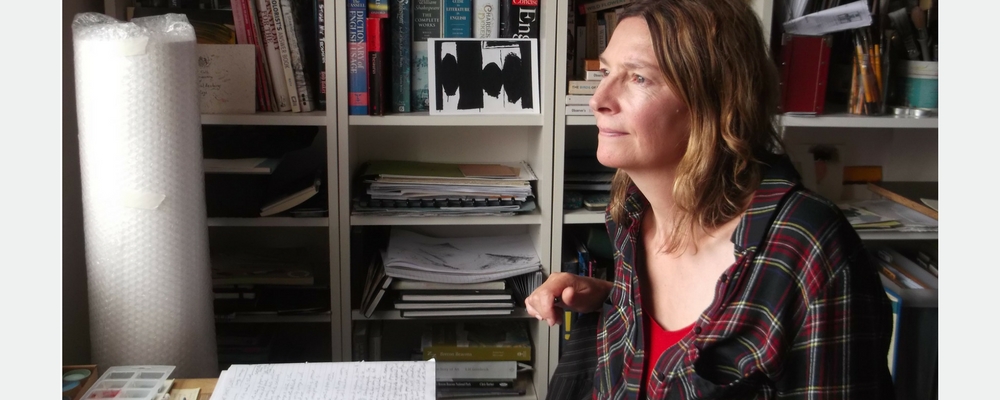 Cath in her home studio
Cath in her home studio
Thanks to our Heritage Lottery Funding, we were able to select four visual artists and one writer to record and document the work at Llwyn Celyn. Each artist has approached the challenge in a different way, partly because we deliberately chose artists working in different art forms and partly because each has found something unique to respond to.
Cath paints and draws, and her work appears on the surface to be quick abstract responses to a landscape, but as you familiarise yourself with these marks you begin to sense that they are gathered impressions over time, the result of many exchanges with the landscape.
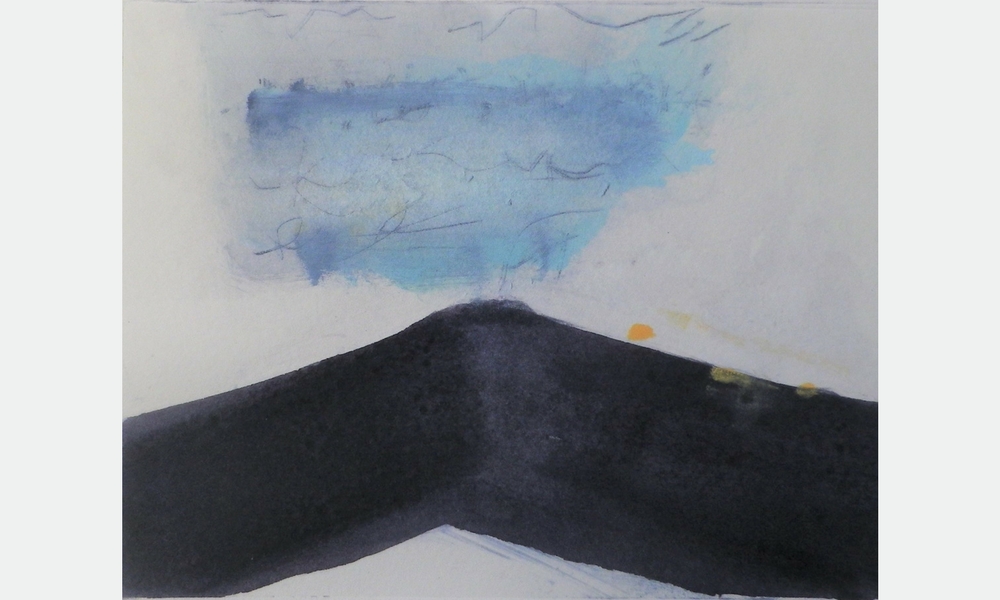
'Black-Plum Mountain' Drypoint, Monoprint and Ink
For Llwyn Celyn Cath is working on two large drawings – one in response to her visits to the site itself and the other to the wider landscape of the Llanthony Valley around it. Cath has been repeating three walks around the site. One takes you up onto Bryn Arw, to a wonderful vantage point where Llwyn Celyn is seen against the backdrop of the Gaer, on which sits an Iron Age hill fort. Another walk is up to the Gaer itself, from which you can look down onto the Llanthony Valley and see the pattern of ancient fields, the dividing line between lowland and upland, and the sheep picking their way through ancestral tracks. The third walk takes her across the Honddu River and upwards on to the Hatterall Ridge, where another view of Llwyn Celyn and its surroundings can be viewed. All these landscapes can be read by unpicking the visual clues. Cath absorbs these narratives and records them in her own codices of gathered pages – unique documents that are as much works of art as her finished images.
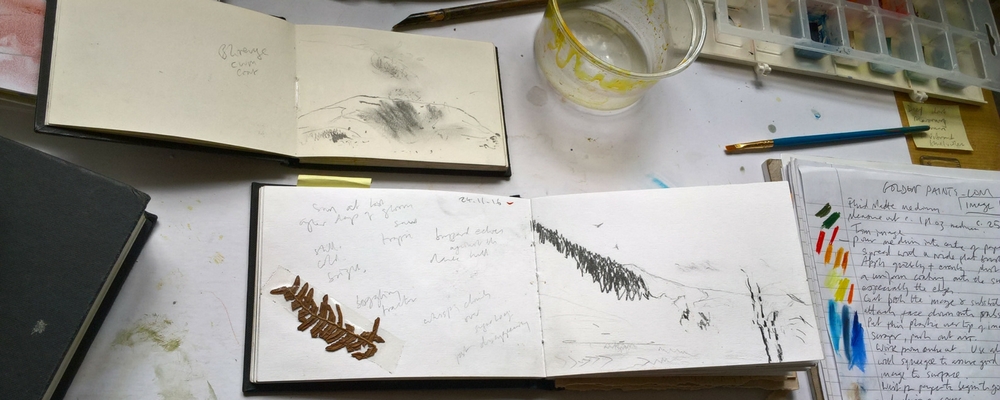
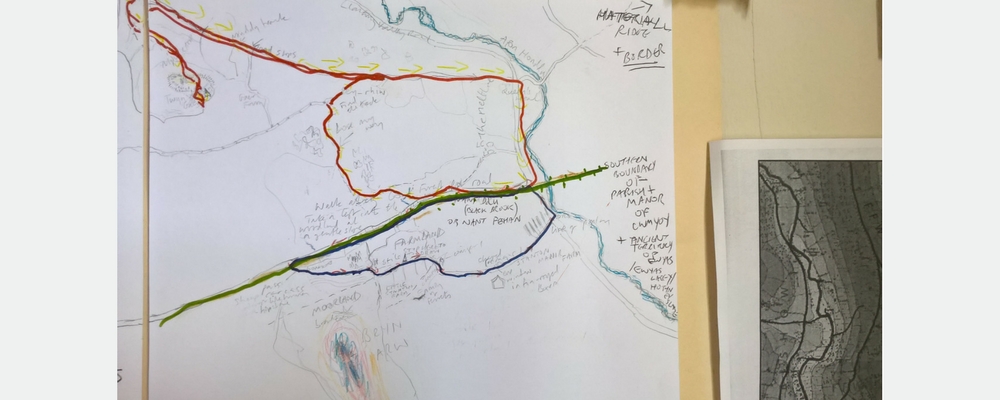
Sketch book pages and notes from Cath's walks around Llwyn Celyn
Cath keeps a map of her walks where she records her many experiences and impressions. ‘I just want to keep moving and experimenting – but always starting from landscape.’
In the application for the residencies, we challenged the artists to do something new – to expand their work into a new area or material. For Cath it was the subject matter, a medieval building channelling a medieval landscape, which gave her a new challenge.
‘I’m interested in what people are doing and the craftsmanship. I don’t use figures in my work, so it won’t become figurative in any way but I might use quotes from people. It is interesting working in a building – I haven’t really done that before.’
Cath has been accessing local field names via the Cynefin website. She is also experimenting with image transfers to create textures reminiscent of the old plaster walls in Llwyn Celyn – sometimes using thick paint which can be sanded down. She has also collected texture rubbings from different surfaces on the site.
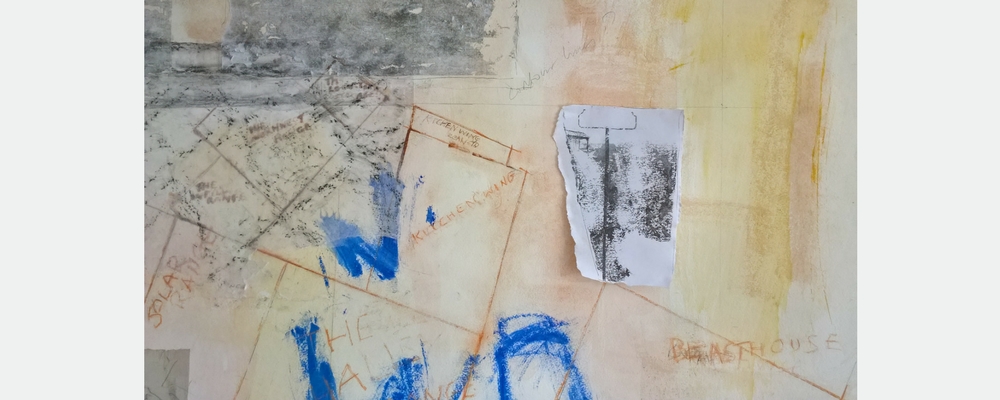
Rubbings of materials and textures found on site
Artists often talk about ‘mark making’, almost as if describing a unique fingerprint or gesture. Cath says: ‘It’s about finding a certain way of using a material to describe something. Using different thicknesses and gestures for a line or shape, for example using a crayon on its edge so you get thick, dense marks, or pen and ink to give finer lines. Mixing different media together too, and taking away.’ This process of ‘taking away’ is key to Cath’s working method. She does not hide where she has removed a mark, and it’s not about a mark being wrong either.
‘Taking away is just as important as adding,’ she emphasises. Cath shows me a beautiful, almost fragile image that includes an outline of the Blorenge and fragments of the landscape below the mountain. ‘I’ve been working on it maybe for a period of 2 years. I add bits here and there or take them away, until I’m happy with the composition and it conveys to me something of the essence of my original response to the subject. I think it’s finished now.’ The decision to finish the work appears a mutual one, made with the mountain, so connected does she seem with it.
The ‘taking away’ is not only a response to revisiting a place many times over in the course of creating an artwork, but also part of achieving an aesthetic. Cath is influenced by the Minimalism ‘…lots of quiet then an interesting small area of detail’. On her studio wall a quote relating to John Cage’s music distils this perfectly into words: The delicate counterpoint of sound and silence. ‘That’s what I want to try and get into my work. It’s quite an abstract concept.’
It is exactly this delicate counterpoint that has drawn visitors to the Llanthony Valley for hundreds of years, in search of their own personal balance between sound and silence. Cath’s completed works will help to communicate this as part of our interpretation area in an old Beast House on the site, which is itself the product of hundreds of years of adding and taking away.